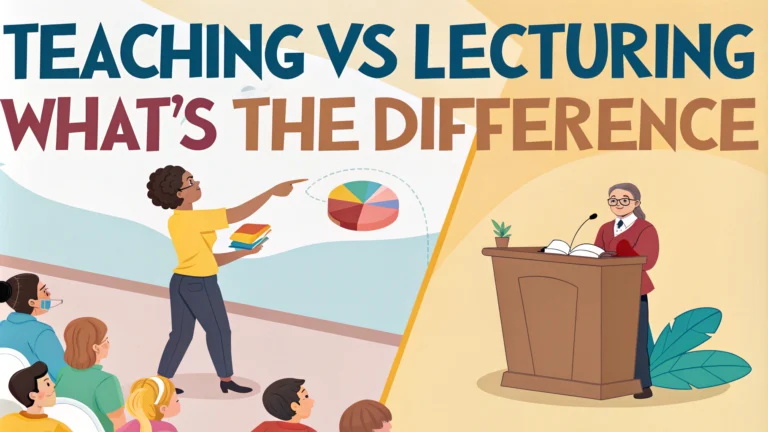The difference between teaching and lecturing shapes how students learn and engage with educational content. A clear understanding of these two distinct approaches helps educators choose the most effective method for their learning objectives.
Educational success often depends on selecting the right instructional method for specific learning situations. Both teaching and lecturing serve different purposes and produce different learning outcomes.
Key Differences Between Teaching and Lecturing
- Interaction level: Teaching involves two-way communication, while lecturing follows one-way information flow
- Student engagement: Teaching encourages active participation; lecturing typically involves passive listening
- Group size: Teaching works best with smaller groups, lecturing suits larger audiences
- Feedback mechanisms: Teaching provides immediate feedback loops; lecturing offers limited feedback opportunities
Essential Components of Effective Teaching
- Interactive elements: Group discussions, hands-on activities, peer learning
- Personalization: Adapting content to individual learning styles
- Assessment methods: Continuous evaluation through various formats
| Teaching Element | Purpose |
|---|---|
| Discussion | Builds critical thinking |
| Activities | Reinforces learning |
| Feedback | Guides improvement |
When to Choose Lecturing
- Large audience scenarios: Conferences, introductory courses
- Time constraints: When covering extensive material quickly
- Expert knowledge sharing: Specialized topics or advanced concepts
> “The best teachers are those who show you where to look but don’t tell you what to see.” – Alexandra K. Trenfor
How Technology Enhances Both Methods
Digital tools create new opportunities for both teaching and lecturing approaches. **Interactive platforms** and **virtual classrooms** allow educators to blend traditional methods with modern technology.
- **Video conferencing** tools enable remote learning while maintaining interaction
- **Learning management systems** help track student progress
- **Digital whiteboards** facilitate real-time collaboration
- **Mobile apps** support instant feedback and assessment
Effective Integration of Teaching and Lecturing
Combining both methods creates a balanced learning environment. Start with a lecture to introduce concepts, then transition to interactive teaching activities.
| Method | Best Use |
|---|---|
| Mini-lectures | Introduction of new topics |
| Group work | Practice and application |
| Hybrid approach | Complex subject matter |
Common Pitfalls to Watch For
Understanding potential problems helps educators maintain effective instruction methods.
- **Overreliance** on one method
- **Poor time management** between activities
- **Lack of clear objectives** for each session
- **Insufficient preparation** for technology use
> “Education is not the filling of a pail, but the lighting of a fire.” – W.B. Yeats
Selecting the Right Method for Your Context
Match your teaching approach to specific learning objectives and student needs.
Consider these factors:
- **Student background** and prior knowledge
- **Available resources** and technology
- **Time constraints** and schedule flexibility
- **Learning outcomes** and assessment requirements
Method Selection Guidelines
| Scenario | Recommended Approach |
|---|---|
| New concept introduction | Brief lecture followed by discussion |
| Skill development | Interactive teaching with practice |
| Complex problem-solving | Combined approach with guided practice |
FAQs About Teaching vs Lecturing
General Questions
Q: What is the main difference between teaching and lecturing?
A: Teaching is an interactive, two-way process focused on student understanding and engagement, while lecturing is primarily a one-way delivery of information from instructor to audience.
Q: Which method is more effective for student learning?
A: Teaching typically produces better learning outcomes as it involves active participation, feedback, and personalized attention. Lectures are more efficient for delivering large amounts of information but may result in lower retention rates.
Teaching-Specific Questions
Q: What are the key components of effective teaching?
A: Effective teaching includes:
- Student engagement
- Interactive discussions
- Hands-on activities
- Regular feedback
- Assessment of understanding
Q: How do you measure teaching effectiveness in the classroom?
A: Teaching effectiveness is measured through:
- Student performance metrics
- Class participation levels
- Learning outcome achievements
- Student feedback surveys
- Peer observations
Lecture-Related Questions
Q: What makes a lecture engaging for students?
A: Engaging lectures incorporate:
- Clear structure
- Real-world examples
- Visual aids
- Periodic Q&A segments
- Relevant case studies
Q: When is lecturing more appropriate than interactive teaching?
A: Lecturing is more appropriate for:
- Large audience settings
- Introducing new concepts
- Time-constrained situations
- Expert presentations
Q: How long should an effective lecture last?
A: Research suggests optimal lecture duration is 20-30 minutes, with breaks or activity changes to maintain attention.
Long-tail Keyword Questions
Q: How to convert traditional lectures into interactive teaching sessions?
A: Traditional lectures can be converted by adding discussion breaks, incorporating group activities, using polling tools, and implementing think-pair-share exercises.
Q: What technology tools improve teaching vs lecturing effectiveness?
A: Key technology tools include:
| Teaching Tools | Lecturing Tools |
|---|---|
| Interactive whiteboards | Presentation software |
| Student response systems | Recording equipment |
| Learning management systems | Document cameras |
Q: Which teaching methods work best for different learning styles?
A: Different methods suit different learners:
- Visual learners: diagrams, charts, videos
- Auditory learners: discussions, verbal explanations
- Kinesthetic learners: hands-on activities, experiments
- Reading/writing learners: written assignments, note-taking



















